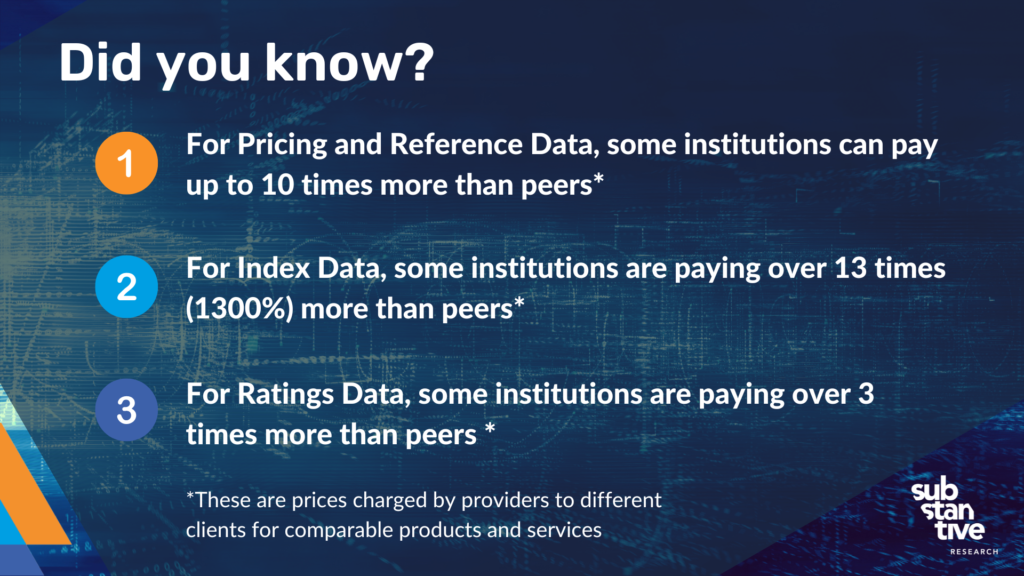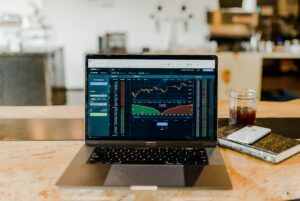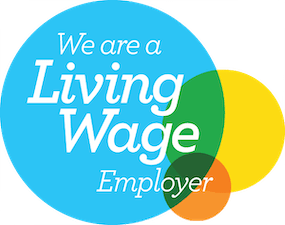Shines a light on opaque pricing frameworks across indices, ratings, research and analytics markets, terminals, and pricing and reference data…

London, 31 October 2022: Substantive Research, the research and data discovery and spend analytics provider for the buy-side, today publishes insights on the current state of the Market Data pricing market, with a specific focus on opaque pricing across indices, ratings, research and analytics markets, terminals, and pricing and reference data.
Today’s findings build on Substantive Research’s June 2022 study which identified that there was a large variance in market data pricing. At the time, index market specific pricing disparities between wholesale market data buyers with similar use cases showed that some institutions are paying more than twice as much as their peers for a single index from the same provider and almost five times more for reporting licenses.
Substantive Research’s latest insights and analytics illustrate that these inconsistencies continue throughout the Market Data industry’s pricing, posing significant challenges for Heads of Market Data globally, who need to navigate a lack of transparency around pricing and the availability of viable market data alternatives. This legacy opacity contributes to annual cost increases and complex relationships with a network of different providers. At the same time, Market Data procurement teams are struggling to manage costs with data budgets filled with ‘have-to-have’ benchmarks and Market Data spend.
Mike Carrodus, CEO of Substantive Research, said: “The pricing in these vital procurements is traditionally opaque and difficult to understand in context with peer procurement spend. Some providers are more inconsistent in what they charge than others, which is important to understand as this will change consumers’ strategy and approach in each case.”
Overall findings on pricing inconsistencies for the last 12 months include:
In the Pricing and Reference Data market:
- Some providers are charging certain clients over ten times (1075%) more than other clients for similar products and services
In the Ratings market:
- The lowest to highest pricing for similar ratings products show that some providers are charging certain clients over three times more than other clients for similar products and services
- The range of increases applied with inflation as the driver is also broad here, having grown in 2021 and stabilised in 2022
The Index market (updated with additional insights since June 2022):
- The lowest to highest pricing for similar developed market index products show that some providers are charging certain clients 13 times (1300%) more than other clients for similar products and services
- Inflation-driven increases in pricing are applied inconsistently – and the inconsistency of percentage increases applied due to inflation become greater through 2020, 2021 and 2022
In the Research & Analytics market:
- The lowest to highest pricing for similar terminal products show that some providers are charging certain clients more than three and a half times more than other clients for similar products and services
- A minority of providers in this area are entirely consistent with their pricing, applying a standardised charging model in contrast to the rest of the market
Krystal Somaza, Head of Data & Analytics at Substantive Research, said, “Gaining a clear perspective of pricing in these markets has always been a challenge, given every firm’s differences in terms of its size, structure and business model, and their specific and unique use cases with each vendor. But transparency is key for procurers, where an incumbent provider base has ensured formidable pricing power in a market with limited alternatives available to buyers.”
Substantive’s methodology can now provide an industry-first, standardised perspective for consumers of market data, which delivers the following conclusions:
- While pricing power is firmly in the hands of the sellers, best practice in negotiation delivers results. This may not drive huge price decreases given the power dynamics in this market, but is proven to mitigate the level of increases year-on-year per provider and therefore impact materially across the entire budget.
- Pricing inconsistency cannot be explained by differences in the clients’ structures, needs and requirements. These factors all drive pricing, but once these factors are all accounted for, prices still vary significantly.
- Even with a strong focus on standardisation and consistent pricing, vendors would struggle – they and their client base regularly go through mergers and acquisitions, the size of each client changes with market cycles and requirements have become more sophisticated from their client base.
Mike Carrodus, CEO of Substantive Research, added, “Many incumbent vendors have been extremely successful in becoming ‘have-to-have’ through investment in their products, technology and marketing capabilities, so their leverage in pricing can be seen as a natural reward for these efforts. However, within a volatile market climate, procurers are more focused than ever on ensuring efficiency in their market data budgets, creating an adversarial negotiation dynamic which is exacerbated in tough times.”
He concluded, “Greater transparency can only ensure the right balance between providing the right incentives for vendors, while also allowing consumers to optimise their budgets. We’re proud to be able to respond to our customer’s wishes in this way and use our proven methodologies to help them understand the truth within these opaque pricing frameworks.”
The Substantive Research insights are based on the latest data generated by its Market Data Spend Analytics tool which was launched in June 2022 as the industry-first “apples-to-apples” Market Data Spend Analytics service. It allows long-only asset managers, wealth managers and hedge funds to truly understand and compare their market data payments and budgeting with the wider market and against their peers.
Universe of survey data:
40 asset management firms, 60%/40% Europe/North America, Total AUM represented $5tr, 70%/30% Long-only/Hedge Fund.








